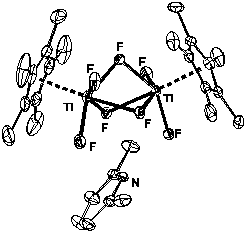
THE CRYSTAL STRUCTURE OF LUTIDINIUM ORGANOFLUOROTITANATE, [LutH]+[(C5Me5)2Ti2F7]- (Lut = 2,6-DIMETHYLPYRIDINE, C5NH3(CH3)2)
Alojz Demšar, Ivan Leban, Saša Petricek, Andrej Pevec1and Joachim Sieler2
1Faculty
of Chemistry and Chemical Technology, University of Ljubljana,
Aškerèeva 5, SLO-1000 Ljubljana, Slovenia, e-mail: ivan.leban@uni-lj.si
2Department of
Inorganic Chemistry, University Leipzig, Linnéstrasse 3, D-04103
Leipzig, Germany
The title compound was prepared from C5Me5TiF3, lutidinium hydrofluoride Lut+2HF and lutidine. Crystal data: orthorombic, Fdd2, a = 21.411(4) , b = 22.446(4), c = 24.727(5) Å, Dc = 1.358 g cm-3, Z = 16, T = 293 K. l = 0.71073 Å , fullmatrix leastsquares refinement on F2, 7180 reflexions, 334 parameters, absolute configuration determined by refinement of Flack parameter (0.02(2)), R1= 0.0355, wR2 = 0.0901. The structure is built from lutidinium cations and organofluorotitanate anions, connected by N-H++F hydrogen bonds of 2.626(5) Å. The anion consists of two titanium atoms bridged by three fluorine atoms. The coordination sphere of titanium is completed by two fluorines and C5Me5 ligand. The Ti-F bond distances are from 1.834(2) to 2.180(2) Å, the longest the Ti-F distances are in trans position to the C5Me5 ligand.
The structure of anion is similar to those found in [{(C5Me4Et)TiF3}4CaF2] [ 1].
[1] A. Pevec, A. Demsar, V. Gramlich, S.Petricek and H.W. Roesky, J. Chem. Soc., Dalton Trans., 1997, 2215.
